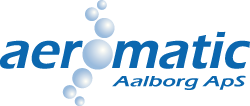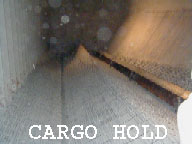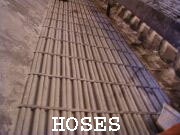

 |
 |
 |
This bulk carrier was converted in the year 2000 from using chain haulage of the cement to using a fluidisation system created by Aeromatic. A total of 13.000 m of the perforated rubber tubes from Aeromatic were installed in the ship.
The M/V Portland was a typical cement bulk carrier with chains in the bottom of the cargo hold of the ship used for unloading. In 2000 the chains and gear wheel needed to be renewed because of wear and tear, which would have been an investment of approximately DKK 1.5 mill every four to five years. Because of this and because the machinery itself was 25 years old, for example the gear box, feed shafts, and stuffing boxes needed a thorough renovation, and because the daily maintenance required about five hours of work every day, an investigation was initiated of the possibilities of changing the unloading system to a pneumatic unloading system using perforated rubber tubes.
The investigation and the tests ended with a full-scale test, where a chain was removed and replaced by a floor of perforated rubber tubes. The test showed that the unloading rate of the ship could be improved by 60-80 % when removing a chain and converting the cargo hold of the ship to an almost maintenance-free fluidization system with rubber tubes.
The basic idea used in the conversion of M/V Portland is that the cargo hold is divided into two or more ditches across, possibly with a bulkhead at the centre dependening on the number of cargo holds that are chosen in the ship. The angle towards the middle of the ditch is between 20 and 25 degrees and furthermore the ditch leans toward the vertical screws by eight to ten degrees. In the ditches the perforated rubber tubes from Aeromatic are installed and when applying compressed air of approximately four bars through the tubes the cement fluidises and flows towards the outlet of the cargo hold through a gate valve and further on to the vertical screw conveyers and is subsequently transported up and out of the ship through a cross screw or by two cement pumps.
Aeromatic has also been involved in a project concerning the M/V Cemclipper. In this project the perforated rubber tubes from Aeromatic were installed in the discharging pipe using manual aeration to optimise the speed of the discharge and the unloading capacity and also to prevent any clocking of the pipes during the discharge.
Projects |
Aeromatic Aalborg ApS - Mylius Erichsensvej 4 - 9210 Aalborg SØ - Tlf: +45 9814 7565 - Mobile: +45 2144 0290 - Email: krogh@aeromatic.dk |